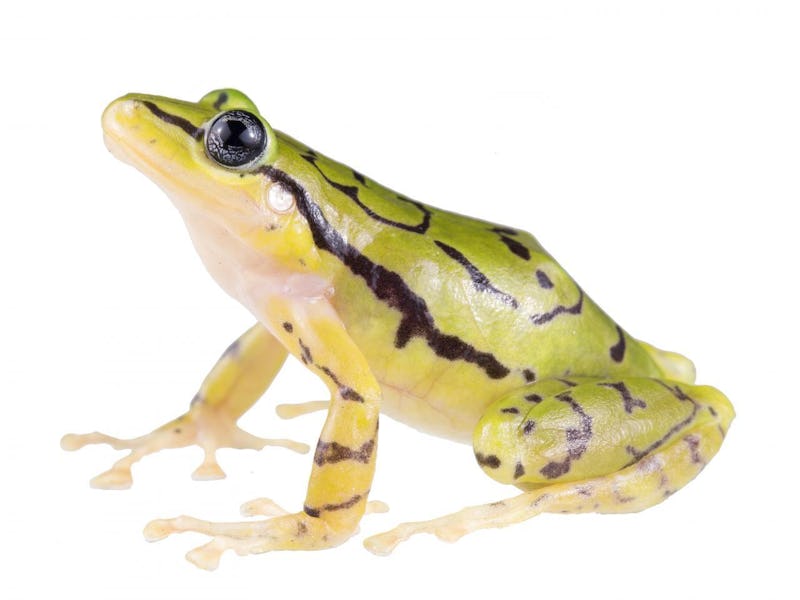We Just Found a Brand New Frog and It is Spectacular
A lesson in why speciation is complicated.

Biologists studying a threatened species of South American rain frog ended up discovering an entirely different species of rain frog, and presumably weren’t even mad because it’s really, really pretty. And besides that new frog from the Peruvian Andes that was the first amphibian named after Sir David Attenborough, it’s high time we get some frog news that’s not Nazi-related anyway.
This other new frog was named Pristimantis ecuadorensis to honor the “overwhelming beauty, and cultural and biological diversity,” of Ecuadorian region where it was found.
The researchers believe it was actually very abundant in that area during the 1980s — when less of the cloud forest habitat had been converted for agricultural purposes — but went unremarked upon because people kept assuming it was the same as the similar (and also pretty) Pristimantis ornatissimus. But a field campaign to study the latter revealed that the two are distinct, proving once again that while speciation seems like it should be a fairly straight-forward field, it’s surprisingly easy to confuse one species for another. The research was published online Wednesday in the journal PLOS ONE.
“In most cases, speciation is facilitated by geographic barriers (e.g., mountains, river valleys),” lead author Juan Guayasamin explained to Inverse over email. “In the case of the split between Pristimantis ornatissimus and the new species (P. ecuadorensis), there are no obvious barriers … Although we tested for environmental differences, we were unable to find any. My guess is that there are some differences (microclimatic), but the environmental layers that we are using might be too broad to capture the difference. That is why there is still uncertainty.”
It’s difficult to say for sure what causes a species to break off from one lineage into something new. The common theory about geographic barriers, which often facilitates the evolution of new traits and behaviors, doesn’t apply, leaving the researchers to guess that perhaps the split has something to do with the higher elevation where the new frog resides (as compared to ornatissimus, which lives lower down).
Hey.
The researchers performed DNA sequencing after suspecting that one population of the frog they were observing was separate from the others. Guayasamin believes the discovery is important because it highlights how agriculture can threaten species that exist in a naturally restricted range, and hopes the name will draw attention to additional conservation efforts.
Ecuador already has nearly 600 species of frogs due to its ridiculous amount of biodiversity — coastline, Amazon basin, and Andes mountains, the last of which contains the Las Pampas region where the new species was found. Pristimantis is actually the most diverse terrestrial vertebrate genus on Earth. These particular frogs are direct developers, meaning they don’t have a tadpole stage. When the embryos hatch, they’re just lil frogs.
Ribbit.
Abstract
Geographic barriers and elevational gradients have long been recognized as important in species diversification. Here, we illustrate an example where both mechanisms have shaped the genetic structure of the Neotropical rainfrog, Pristimantis ornatissimus, which has also resulted in speciation. This species was thought to be a single evolutionary lineage distributed throughout the Ecuadorian Chocó and the adjacent foothills of the Andes. Based on recent sampling of P. ornatissimus sensu lato, we provide molecular and morphological evidence that support the validity of a new species, which we name Pristimantis ecuadorensis sp. nov. The sister species are elevational replacements of each other; the distribution of Pristimantis ornatissimus sensu stricto is limited to the Ecuadorian Chocó ecoregion (< 1100 m), whereas the new species has only been found at Andean localities between 1450–1480 m. Given the results of the Multiple Matrix Regression with Randomization analysis, the genetic difference between P. ecuadorensis and P. ornatissimus is not explained by geographic distance nor environment, although environmental variables at a finer scale need to be tested. Therefore this speciation event might be the byproduct of stochastic historic extinction of connected populations or biogeographic events caused by barriers to dispersal such as rivers. Within P. ornatissimus sensu stricto, morphological patterns and genetic structure seem to be related to geographic isolation (e.g., rivers). Finally, we provide an updated phylogeny for the genus, including the new species, as well as other Ecuadorian Pristimantis.